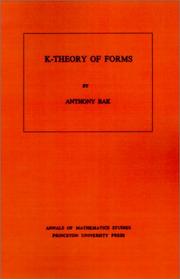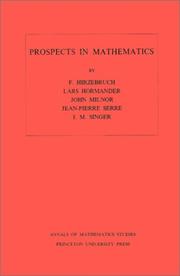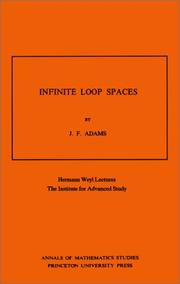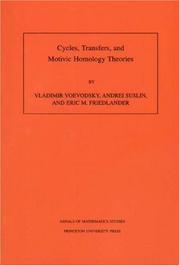| Listing 1 - 9 of 9 |
Sort by
|
Book
ISBN: 1282372629 9786612372629 3110213184 9783110213188 9783110207460 311020746X 9781282372627 6612372621 Year: 2009 Publisher: Berlin New York Walter De Gruyter
Abstract | Keywords | Export | Availability | Bookmark
 Loading...
Loading...Choose an application
- Reference Manager
- EndNote
- RefWorks (Direct export to RefWorks)
This volume contains selected refereed papers based on lectures presented at the 'Fifth International Fez Conference on Commutative Algebra and Applications' that was held in Fez, Morocco in June 2008. The volume represents new trends and areas of classical research within the field, with contributions from many different countries. In addition, the volume has as a special focus the research and influence of Alain Bouvier on commutative algebra over the past thirty years.
Commutative algebra --- Algebra --- Algebraic Geometry. --- Algebraic Number Theory. --- Commutative Algebra. --- Module Theory. --- Monoid Theory.

ISBN: 069108274X 0691082758 1400881412 9780691082752 9780691082745 Year: 2016 Volume: 98 Publisher: Princeton, NJ : Princeton University Press,
Abstract | Keywords | Export | Availability | Bookmark
 Loading...
Loading...Choose an application
- Reference Manager
- EndNote
- RefWorks (Direct export to RefWorks)
The description for this book, K-Theory of Forms. (AM-98), Volume 98, will be forthcoming.
Category theory. Homological algebra --- 515.14 --- Algebraic topology --- 515.14 Algebraic topology --- Forms (Mathematics) --- K-theory --- Modules (Algebra) --- Finite number systems --- Modular systems (Algebra) --- Algebra --- Finite groups --- Rings (Algebra) --- Homology theory --- Quantics --- Mathematics --- K-theory. --- Abelian group. --- Addition. --- Algebraic K-theory. --- Algebraic topology. --- Approximation. --- Arithmetic. --- Canonical map. --- Coefficient. --- Cokernel. --- Computation. --- Coprime integers. --- Coset. --- Direct limit. --- Direct product. --- Division ring. --- Elementary matrix. --- Exact sequence. --- Finite group. --- Finite ring. --- Free module. --- Functor. --- General linear group. --- Global field. --- Group homomorphism. --- Group ring. --- Homology (mathematics). --- Integer. --- Invertible matrix. --- Isomorphism class. --- Linear map. --- Local field. --- Matrix group. --- Maxima and minima. --- Mayer–Vietoris sequence. --- Module (mathematics). --- Monoid. --- Morphism. --- Natural transformation. --- Normal subgroup. --- P-group. --- Parameter. --- Power of two. --- Product category. --- Projective module. --- Quadratic form. --- Requirement. --- Ring of integers. --- Semisimple algebra. --- Sesquilinear form. --- Special case. --- Steinberg group (K-theory). --- Steinberg group. --- Subcategory. --- Subgroup. --- Subspace topology. --- Surjective function. --- Theorem. --- Theory. --- Topological group. --- Topological ring. --- Topology. --- Torsion subgroup. --- Triviality (mathematics). --- Unification (computer science). --- Unitary group. --- Witt group. --- K-théorie
Book
ISBN: 0691189633 Year: 2019 Publisher: Princeton, NJ : Princeton University Press,
Abstract | Keywords | Export | Availability | Bookmark
 Loading...
Loading...Choose an application
- Reference Manager
- EndNote
- RefWorks (Direct export to RefWorks)
This book presents the complete proof of the Bloch-Kato conjecture and several related conjectures of Beilinson and Lichtenbaum in algebraic geometry. Brought together here for the first time, these conjectures describe the structure of étale cohomology and its relation to motivic cohomology and Chow groups.Although the proof relies on the work of several people, it is credited primarily to Vladimir Voevodsky. The authors draw on a multitude of published and unpublished sources to explain the large-scale structure of Voevodsky's proof and introduce the key figures behind its development. They go on to describe the highly innovative geometric constructions of Markus Rost, including the construction of norm varieties, which play a crucial role in the proof. The book then addresses symmetric powers of motives and motivic cohomology operations.Comprehensive and self-contained, The Norm Residue Theorem in Motivic Cohomology unites various components of the proof that until now were scattered across many sources of varying accessibility, often with differing hypotheses, definitions, and language.
Homology theory. --- Cohomology theory --- Contrahomology theory --- Algebraic topology --- 5P. --- Abelian group. --- Addition. --- Additive category. --- Adjoint functors. --- Alexander Grothendieck. --- Algebraic closure. --- Algebraic cobordism. --- Algebraic cycle. --- Algebraic extension. --- Algebraic geometry. --- Algebraic topology. --- Andrei Suslin. --- Axiom. --- Characteristic class. --- Classifying space. --- Closed set. --- Codimension. --- Cofibration. --- Cohomology operation. --- Cohomology. --- Conjecture. --- Corollary. --- Diagram (category theory). --- Direct limit. --- Exact sequence. --- Factorization. --- Fibration. --- Functor. --- Galois cohomology. --- Galois extension. --- Group object. --- Homology (mathematics). --- Homotopy category. --- Homotopy. --- Hypersurface. --- Inverse function. --- Mathematical induction. --- Mathematics. --- Milnor K-theory. --- Model category. --- Module (mathematics). --- Monoid. --- Monomorphism. --- Morphism. --- Motivic cohomology. --- Natural number. --- Normal bundle. --- Open set. --- Presheaf (category theory). --- Pushout (category theory). --- Quantity. --- Quillen adjunction. --- Rational point. --- Regular representation. --- Remainder. --- Retract. --- Separable extension. --- Sheaf (mathematics). --- Smooth scheme. --- Special case. --- Subgroup. --- Summation. --- Tangent space. --- Theorem. --- Trivial representation. --- Vladimir Voevodsky. --- Weak equivalence (homotopy theory).

ISBN: 0691080941 9780691080949 1400881692 Year: 1971 Volume: 70 Publisher: Princeton : Princeton University Press,
Abstract | Keywords | Export | Availability | Bookmark
 Loading...
Loading...Choose an application
- Reference Manager
- EndNote
- RefWorks (Direct export to RefWorks)
Five papers by distinguished American and European mathematicians describe some current trends in mathematics in the perspective of the recent past and in terms of expectations for the future. Among the subjects discussed are algebraic groups, quadratic forms, topological aspects of global analysis, variants of the index theorem, and partial differential equations.
Mathematics --- Mathématiques --- Congresses --- Congrès --- 51 --- -Math --- Science --- Congresses. --- -Mathematics --- 51 Mathematics --- -51 Mathematics --- Math --- Mathématiques --- Congrès --- A priori estimate. --- Addition. --- Additive group. --- Affine space. --- Algebraic geometry. --- Algebraic group. --- Atiyah–Singer index theorem. --- Bernoulli number. --- Boundary value problem. --- Bounded operator. --- C*-algebra. --- Canonical transformation. --- Cauchy problem. --- Characteristic class. --- Clifford algebra. --- Coefficient. --- Cohomology. --- Commutative property. --- Commutative ring. --- Complex manifold. --- Complex number. --- Complex vector bundle. --- Dedekind sum. --- Degenerate bilinear form. --- Diagram (category theory). --- Diffeomorphism. --- Differentiable manifold. --- Differential operator. --- Dimension (vector space). --- Ellipse. --- Elliptic operator. --- Equation. --- Euler characteristic. --- Euler number. --- Existence theorem. --- Exotic sphere. --- Finite difference. --- Finite group. --- Fourier integral operator. --- Fourier transform. --- Fourier. --- Fredholm operator. --- Hardy space. --- Hilbert space. --- Holomorphic vector bundle. --- Homogeneous coordinates. --- Homomorphism. --- Homotopy. --- Hyperbolic partial differential equation. --- Identity component. --- Integer. --- Integral transform. --- Isomorphism class. --- John Milnor. --- K-theory. --- Lebesgue measure. --- Line bundle. --- Local ring. --- Mathematics. --- Maximal ideal. --- Modular form. --- Module (mathematics). --- Monoid. --- Normal bundle. --- Number theory. --- Open set. --- Parametrix. --- Parity (mathematics). --- Partial differential equation. --- Piecewise linear manifold. --- Poisson bracket. --- Polynomial ring. --- Polynomial. --- Prime number. --- Principal part. --- Projective space. --- Pseudo-differential operator. --- Quadratic form. --- Rational variety. --- Real number. --- Reciprocity law. --- Resolution of singularities. --- Riemann–Roch theorem. --- Shift operator. --- Simply connected space. --- Special case. --- Square-integrable function. --- Subalgebra. --- Submanifold. --- Support (mathematics). --- Surjective function. --- Symmetric bilinear form. --- Symplectic vector space. --- Tangent space. --- Theorem. --- Topology. --- Variable (mathematics). --- Vector bundle. --- Vector space. --- Winding number. --- Mathematics - Congresses

ISBN: 0691082073 0691082065 1400821258 Year: 1978 Volume: no. 90 Publisher: Princeton, NJ : Princeton University Press,
Abstract | Keywords | Export | Availability | Bookmark
 Loading...
Loading...Choose an application
- Reference Manager
- EndNote
- RefWorks (Direct export to RefWorks)
The theory of infinite loop spaces has been the center of much recent activity in algebraic topology. Frank Adams surveys this extensive work for researchers and students. Among the major topics covered are generalized cohomology theories and spectra; infinite-loop space machines in the sense of Boadman-Vogt, May, and Segal; localization and group completion; the transfer; the Adams conjecture and several proofs of it; and the recent theories of Adams and Priddy and of Madsen, Snaith, and Tornehave.
Algebraic topology --- Loop spaces --- Espaces de lacets --- Infinite loop spaces. --- Abelian group. --- Adams spectral sequence. --- Adjoint functors. --- Algebraic K-theory. --- Algebraic topology. --- Automorphism. --- Axiom. --- Bott periodicity theorem. --- CW complex. --- Calculation. --- Cartesian product. --- Cobordism. --- Coefficient. --- Cofibration. --- Cohomology operation. --- Cohomology ring. --- Cohomology. --- Commutative diagram. --- Continuous function. --- Counterexample. --- De Rham cohomology. --- Diagram (category theory). --- Differentiable manifold. --- Dimension. --- Discrete space. --- Disjoint union. --- Double coset. --- Eilenberg. --- Eilenberg–Steenrod axioms. --- Endomorphism. --- Epimorphism. --- Equivalence class. --- Euler class. --- Existential quantification. --- Explicit formulae (L-function). --- Exterior algebra. --- F-space. --- Fiber bundle. --- Fibration. --- Finite group. --- Function composition. --- Function space. --- Functor. --- Fundamental class. --- Fundamental group. --- Geometry. --- H-space. --- Homology (mathematics). --- Homomorphism. --- Homotopy category. --- Homotopy group. --- Homotopy. --- Hurewicz theorem. --- Inverse limit. --- J-homomorphism. --- K-theory. --- Limit (mathematics). --- Loop space. --- Mathematical induction. --- Maximal torus. --- Module (mathematics). --- Monoid. --- Monoidal category. --- Moore space. --- Morphism. --- Multiplication. --- Natural transformation. --- P-adic number. --- P-complete. --- Parameter space. --- Permutation. --- Prime number. --- Principal bundle. --- Principal ideal domain. --- Pullback (category theory). --- Quotient space (topology). --- Reduced homology. --- Riemannian manifold. --- Ring spectrum. --- Serre spectral sequence. --- Simplicial set. --- Simplicial space. --- Special case. --- Spectral sequence. --- Stable homotopy theory. --- Steenrod algebra. --- Subalgebra. --- Subring. --- Subset. --- Surjective function. --- Theorem. --- Theory. --- Topological K-theory. --- Topological ring. --- Topological space. --- Topology. --- Universal bundle. --- Universal coefficient theorem. --- Vector bundle. --- Weak equivalence (homotopy theory). --- Topologie algébrique

ISBN: 0691048142 0691048150 9786613379825 1283379821 140083712X 9780691048147 9780691048154 Year: 2011 Volume: 143 Publisher: Princeton, NJ : Princeton University Press,
Abstract | Keywords | Export | Availability | Bookmark
 Loading...
Loading...Choose an application
- Reference Manager
- EndNote
- RefWorks (Direct export to RefWorks)
The original goal that ultimately led to this volume was the construction of "motivic cohomology theory," whose existence was conjectured by A. Beilinson and S. Lichtenbaum. This is achieved in the book's fourth paper, using results of the other papers whose additional role is to contribute to our understanding of various properties of algebraic cycles. The material presented provides the foundations for the recent proof of the celebrated "Milnor Conjecture" by Vladimir Voevodsky. The theory of sheaves of relative cycles is developed in the first paper of this volume. The theory of presheaves with transfers and more specifically homotopy invariant presheaves with transfers is the main theme of the second paper. The Friedlander-Lawson moving lemma for families of algebraic cycles appears in the third paper in which a bivariant theory called bivariant cycle cohomology is constructed. The fifth and last paper in the volume gives a proof of the fact that bivariant cycle cohomology groups are canonically isomorphic (in appropriate cases) to Bloch's higher Chow groups, thereby providing a link between the authors' theory and Bloch's original approach to motivic (co-)homology.
Bundeltheorie --- Cohomology [Sheaf ] --- Faisceaux [Théorie des ] --- Sheaf cohomology --- Sheaf theory --- Sheaves (Algebraic topology) --- Sheaves [Theory of ] --- Théorie des faisceaux --- Algebraic cycles --- Homology theory --- Algebraic cycles. --- Homology theory. --- Cohomology theory --- Contrahomology theory --- Algebraic topology --- Cycles, Algebraic --- Geometry, Algebraic --- Abelian category. --- Abelian group. --- Addition. --- Additive category. --- Adjoint functors. --- Affine space. --- Affine variety. --- Alexander Grothendieck. --- Algebraic K-theory. --- Algebraic cycle. --- Algebraically closed field. --- Andrei Suslin. --- Associative property. --- Base change. --- Category of abelian groups. --- Chain complex. --- Chow group. --- Closed immersion. --- Codimension. --- Coefficient. --- Cohomology. --- Cokernel. --- Commutative property. --- Commutative ring. --- Compactification (mathematics). --- Comparison theorem. --- Computation. --- Connected component (graph theory). --- Connected space. --- Corollary. --- Diagram (category theory). --- Dimension. --- Discrete valuation ring. --- Disjoint union. --- Divisor. --- Embedding. --- Endomorphism. --- Epimorphism. --- Exact sequence. --- Existential quantification. --- Field of fractions. --- Functor. --- Generic point. --- Geometry. --- Grothendieck topology. --- Homeomorphism. --- Homogeneous coordinates. --- Homology (mathematics). --- Homomorphism. --- Homotopy category. --- Homotopy. --- Injective sheaf. --- Irreducible component. --- K-theory. --- Mathematical induction. --- Mayer–Vietoris sequence. --- Milnor K-theory. --- Monoid. --- Monoidal category. --- Monomorphism. --- Morphism of schemes. --- Morphism. --- Motivic cohomology. --- Natural transformation. --- Nisnevich topology. --- Noetherian. --- Open set. --- Pairing. --- Perfect field. --- Permutation. --- Picard group. --- Presheaf (category theory). --- Projective space. --- Projective variety. --- Proper morphism. --- Quasi-projective variety. --- Residue field. --- Resolution of singularities. --- Scientific notation. --- Sheaf (mathematics). --- Simplicial complex. --- Simplicial set. --- Singular homology. --- Smooth scheme. --- Spectral sequence. --- Subcategory. --- Subgroup. --- Summation. --- Support (mathematics). --- Tensor product. --- Theorem. --- Topology. --- Triangulated category. --- Type theory. --- Universal coefficient theorem. --- Variable (mathematics). --- Vector bundle. --- Vladimir Voevodsky. --- Zariski topology. --- Zariski's main theorem. --- 512.73 --- 512.73 Cohomology theory of algebraic varieties and schemes --- Cohomology theory of algebraic varieties and schemes
Book
ISBN: 9780691136592 0691136599 9780691138817 0691138818 9786612458361 1282458361 1400829054 9781400829057 9781282458369 6612458364 Year: 2009 Volume: 168 Publisher: Princeton, N.J. Princeton University Press
Abstract | Keywords | Export | Availability | Bookmark
 Loading...
Loading...Choose an application
- Reference Manager
- EndNote
- RefWorks (Direct export to RefWorks)
In The Structure of Affine Buildings, Richard Weiss gives a detailed presentation of the complete proof of the classification of Bruhat-Tits buildings first completed by Jacques Tits in 1986. The book includes numerous results about automorphisms, completions, and residues of these buildings. It also includes tables correlating the results in the locally finite case with the results of Tits's classification of absolutely simple algebraic groups defined over a local field. A companion to Weiss's The Structure of Spherical Buildings, The Structure of Affine Buildings is organized around the classification of spherical buildings and their root data as it is carried out in Tits and Weiss's Moufang Polygons.
Buildings (Group theory) --- Moufang loops --- Automorphisms --- Affine algebraic groups --- Moufang loops. --- Automorphisms. --- Affine algebraic groups. --- Algebraic groups, Affine --- Loops, Moufang --- Theory of buildings (Group theory) --- Tits's theory of buildings (Group theory) --- Group schemes (Mathematics) --- Group theory --- Symmetry (Mathematics) --- Loops (Group theory) --- Linear algebraic groups --- Buildings (Group theory). --- Addition. --- Additive group. --- Additive inverse. --- Algebraic group. --- Algebraic structure. --- Ambient space. --- Associative property. --- Automorphism. --- Big O notation. --- Bijection. --- Bilinear form. --- Bounded set (topological vector space). --- Bounded set. --- Calculation. --- Cardinality. --- Cauchy sequence. --- Commutative property. --- Complete graph. --- Complete metric space. --- Composition algebra. --- Connected component (graph theory). --- Consistency. --- Continuous function. --- Coordinate system. --- Corollary. --- Coxeter group. --- Coxeter–Dynkin diagram. --- Diagram (category theory). --- Diameter. --- Dimension. --- Discrete valuation. --- Division algebra. --- Dot product. --- Dynkin diagram. --- E6 (mathematics). --- E7 (mathematics). --- E8 (mathematics). --- Empty set. --- Equipollence (geometry). --- Equivalence class. --- Equivalence relation. --- Euclidean geometry. --- Euclidean space. --- Existential quantification. --- Free monoid. --- Fundamental domain. --- Hyperplane. --- Infimum and supremum. --- Jacques Tits. --- K0. --- Linear combination. --- Mathematical induction. --- Metric space. --- Multiple edges. --- Multiplicative inverse. --- Number theory. --- Octonion. --- Parameter. --- Permutation group. --- Permutation. --- Pointwise. --- Polygon. --- Projective line. --- Quadratic form. --- Quaternion. --- Remainder. --- Root datum. --- Root system. --- Scientific notation. --- Sphere. --- Subgroup. --- Subring. --- Subset. --- Substructure. --- Theorem. --- Topology of uniform convergence. --- Topology. --- Torus. --- Tree (data structure). --- Tree structure. --- Two-dimensional space. --- Uniform continuity. --- Valuation (algebra). --- Vector space. --- Without loss of generality.
Book
ISBN: 0691138214 1400837111 0691138222 9780691138220 9781400837113 9780691138213 Year: 2009 Publisher: Princeton, N.J. Princeton University Press
Abstract | Keywords | Export | Availability | Bookmark
 Loading...
Loading...Choose an application
- Reference Manager
- EndNote
- RefWorks (Direct export to RefWorks)
In 1970, Phillip Griffiths envisioned that points at infinity could be added to the classifying space D of polarized Hodge structures. In this book, Kazuya Kato and Sampei Usui realize this dream by creating a logarithmic Hodge theory. They use the logarithmic structures begun by Fontaine-Illusie to revive nilpotent orbits as a logarithmic Hodge structure. The book focuses on two principal topics. First, Kato and Usui construct the fine moduli space of polarized logarithmic Hodge structures with additional structures. Even for a Hermitian symmetric domain D, the present theory is a refinement of the toroidal compactifications by Mumford et al. For general D, fine moduli spaces may have slits caused by Griffiths transversality at the boundary and be no longer locally compact. Second, Kato and Usui construct eight enlargements of D and describe their relations by a fundamental diagram, where four of these enlargements live in the Hodge theoretic area and the other four live in the algebra-group theoretic area. These two areas are connected by a continuous map given by the SL(2)-orbit theorem of Cattani-Kaplan-Schmid. This diagram is used for the construction in the first topic.
Hodge theory. --- Logarithms. --- Logs (Logarithms) --- Algebra --- Complex manifolds --- Differentiable manifolds --- Geometry, Algebraic --- Homology theory --- Algebraic group. --- Algebraic variety. --- Analytic manifold. --- Analytic space. --- Annulus (mathematics). --- Arithmetic group. --- Atlas (topology). --- Canonical map. --- Classifying space. --- Coefficient. --- Cohomology. --- Compactification (mathematics). --- Complex manifold. --- Complex number. --- Congruence subgroup. --- Conjecture. --- Connected component (graph theory). --- Continuous function. --- Convex cone. --- Degeneracy (mathematics). --- Diagram (category theory). --- Differential form. --- Direct image functor. --- Divisor. --- Elliptic curve. --- Equivalence class. --- Existential quantification. --- Finite set. --- Functor. --- Geometry. --- Hodge structure. --- Homeomorphism. --- Homomorphism. --- Inverse function. --- Iwasawa decomposition. --- Local homeomorphism. --- Local ring. --- Local system. --- Logarithmic. --- Maximal compact subgroup. --- Modular curve. --- Modular form. --- Moduli space. --- Monodromy. --- Monoid. --- Morphism. --- Natural number. --- Nilpotent orbit. --- Nilpotent. --- Open problem. --- Open set. --- P-adic Hodge theory. --- P-adic number. --- Point at infinity. --- Proper morphism. --- Pullback (category theory). --- Quotient space (topology). --- Rational number. --- Relative interior. --- Ring (mathematics). --- Ring homomorphism. --- Scientific notation. --- Set (mathematics). --- Sheaf (mathematics). --- Smooth morphism. --- Special case. --- Strong topology. --- Subgroup. --- Subobject. --- Subset. --- Surjective function. --- Tangent bundle. --- Taylor series. --- Theorem. --- Topological space. --- Topology. --- Transversality (mathematics). --- Two-dimensional space. --- Vector bundle. --- Vector space. --- Weak topology.
Book
ISBN: 1400883849 Year: 2016 Publisher: Princeton, NJ : Princeton University Press,
Abstract | Keywords | Export | Availability | Bookmark
 Loading...
Loading...Choose an application
- Reference Manager
- EndNote
- RefWorks (Direct export to RefWorks)
When this book was written, methods of algebraic topology had caused revolutions in the world of pure algebra. To clarify the advances that had been made, Cartan and Eilenberg tried to unify the fields and to construct the framework of a fully fledged theory. The invasion of algebra had occurred on three fronts through the construction of cohomology theories for groups, Lie algebras, and associative algebras. This book presents a single homology (and also cohomology) theory that embodies all three; a large number of results is thus established in a general framework. Subsequently, each of the three theories is singled out by a suitable specialization, and its specific properties are studied. The starting point is the notion of a module over a ring. The primary operations are the tensor product of two modules and the groups of all homomorphisms of one module into another. From these, "higher order" derived of operations are obtained, which enjoy all the properties usually attributed to homology theories. This leads in a natural way to the study of "functors" and of their "derived functors." This mathematical masterpiece will appeal to all mathematicians working in algebraic topology.
Homology theory. --- Abelian group. --- Additive group. --- Algebra homomorphism. --- Algebraic topology. --- Anticommutativity. --- Associative algebra. --- Associative property. --- Axiom. --- Betti number. --- C0. --- Category of modules. --- Change of rings. --- Cohomology. --- Cokernel. --- Commutative diagram. --- Commutative property. --- Commutative ring. --- Cyclic group. --- Derived functor. --- Diagram (category theory). --- Differential operator. --- Direct limit. --- Direct product. --- Direct sum of modules. --- Direct sum. --- Duality (mathematics). --- Endomorphism. --- Epimorphism. --- Equivalence class. --- Exact category. --- Exact sequence. --- Existential quantification. --- Explicit formulae (L-function). --- Factorization. --- Field of fractions. --- Finite group. --- Finitely generated module. --- Free abelian group. --- Free monoid. --- Functor. --- Fundamental group. --- G-module. --- Galois theory. --- Global dimension. --- Graded ring. --- Group algebra. --- Hereditary ring. --- Hochschild homology. --- Homological algebra. --- Homology (mathematics). --- Homomorphism. --- Homotopy. --- Hyperhomology. --- I0. --- Ideal (ring theory). --- Inclusion map. --- Induced homomorphism. --- Injective function. --- Injective module. --- Integral domain. --- Inverse limit. --- Left inverse. --- Lie algebra. --- Linear differential equation. --- Mathematical induction. --- Maximal ideal. --- Module (mathematics). --- Monoidal category. --- Natural transformation. --- Noetherian ring. --- Noetherian. --- Permutation. --- Polynomial ring. --- Pontryagin duality. --- Product topology. --- Projective module. --- Quotient algebra. --- Quotient group. --- Quotient module. --- Right inverse. --- Ring (mathematics). --- Ring of integers. --- Separation axiom. --- Set (mathematics). --- Special case. --- Spectral sequence. --- Subalgebra. --- Subcategory. --- Subgroup. --- Subring. --- Summation. --- Tensor product. --- Theorem. --- Topological space. --- Topology. --- Trivial representation. --- Unification (computer science). --- Universal coefficient theorem. --- Variable (mathematics). --- Zero object (algebra).
| Listing 1 - 9 of 9 |
Sort by
|

 Search
Search Feedback
Feedback About
About Help
Help News
News